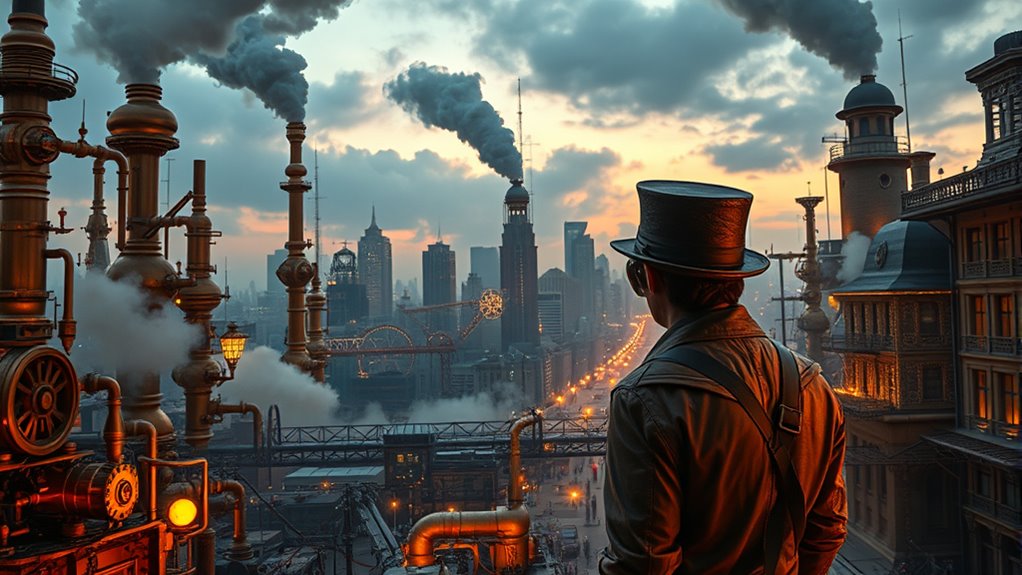Steampunk celebrates the beauty of Victorian-inspired technology, emphasizing craftsmanship and ethical progress. It embraces techno-optimism, believing technological innovation can serve humanity responsibly and sustainably. Yet, it also recognizes dystopian risks, questioning if nostalgia keeps us blind to historical flaws like inequality and environmental harm. By harmonizing industrial beauty with moral responsibility, steampunk invites you to explore how our past shapes future innovations—continue to discover whether hope or caution guides this inventive genre.
Key Takeaways
- Steampunk champions techno-optimism by embracing handcrafted, innovative technologies inspired by Victorian ingenuity.
- It critically examines dystopian themes, highlighting social inequalities and environmental impacts of unchecked industrialization.
- The genre advocates responsible technological development rooted in artisanal craftsmanship and ethical considerations.
- It balances nostalgia for industrial innovation with concerns about potential exploitation and societal decay.
- Steampunk encourages reflective dialogue on how past technological values can inform sustainable, inclusive futures.

Have you ever wondered what drives the unique worldview of steampunk enthusiasts? It’s a blend of industrial nostalgia and a desire for ethical innovation that shapes their perspective. Steampunk draws inspiration from the Victorian age, celebrating the age of steam-powered machinery, intricate gears, and handcrafted details. This love for industrial nostalgia isn’t just about romanticizing the past; it’s about recognizing the ingenuity and craftsmanship that once defined technological progress. You see, steampunk fans often cherish the idea of blending old-world aesthetics with modern ideas, creating a space where technology feels tangible, crafted, and meaningful. It’s a conscious rejection of the sleek, impersonal designs of contemporary tech, favoring instead the charm of visible mechanisms and artisanal details. This approach reflects a yearning for authenticity and a respect for the craftsmanship that went into early innovations.
At the same time, steampunk’s ethos isn’t about blindly glorifying the past. Many enthusiasts see it as a platform for ethical innovation—using the nostalgic appeal of the genre to inspire responsible technological development. They believe that progress should serve humanity, not exploit it, and that technology should be accessible and sustainable. This mindset fosters a sense of optimism about the future, one where technological advancements are driven by creativity and moral responsibility rather than profit or power. Steampunk’s emphasis on handcrafted, often DIY projects underscores this ethic, encouraging individuals to take an active role in shaping their world. It’s about reclaiming control from large corporations and technological conglomerates, emphasizing community, sustainability, and ingenuity.
However, this outlook also opens the door for dystopian concerns. Some see steampunk as a double-edged sword—an aesthetic that can romanticize a time when social inequalities, colonialism, and environmental degradation thrived. It prompts questions about whether idealizing a bygone era risks ignoring its darker aspects. As a steampunk enthusiast, you might wonder if nostalgia blinds us to the lessons of history, or if it merely offers a way to reimagine progress more ethically. The genre’s tension between techno-optimism and dystopian fears keeps it relevant, pushing you to consider whether technological innovation can truly be ethical or if it inevitably leads down a path of exploitation and inequality. Ultimately, steampunk invites you to reflect on how the past shapes your view of the future—balancing admiration for industrial craftsmanship with a conscious effort to pursue progress that’s responsible, inclusive, and sustainable.
Frequently Asked Questions
How Does Steampunk Influence Modern Technological Innovation?
You’re influenced by steampunk’s retro futuristic designs and Victorian innovation, inspiring you to blend old-fashioned aesthetics with modern tech. This mix pushes you to reimagine innovation, emphasizing craftsmanship and sustainability. By drawing on steampunk’s nostalgic yet inventive spirit, you foster creativity and unique problem-solving approaches that could lead to new, eco-friendly technologies rooted in historical design principles. Steampunk encourages you to think beyond current limits, merging past and future ideas seamlessly.
Are There Cultural Differences in Steampunk’s Techno-Optimism Globally?
Like a patchwork quilt, steampunk’s techno-optimism varies across cultures. You’ll find that regional variations shape its appeal and narrative, influenced by cultural perceptions of industrial history and innovation. In some regions, it’s a celebration of technological progress, while others view it as a critique of unchecked industrialism. These differences create a rich tapestry, showing how local histories and values influence steampunk’s global embrace.
Can Steampunk’s Dystopian Themes Inform Real-World Policy Debates?
Yes, steampunk’s dystopian themes can inform real-world policy debates by highlighting historical parallels and ethical implications of unchecked technological progress. As you explore these themes, you might see how past industrial excesses led to environmental and social issues, prompting policymakers to contemplate sustainable development. Engaging with steampunk’s cautionary tales encourages you to debate responsible innovation and balance technological advancement with societal well-being.
How Does Steampunk Challenge Traditional Definitions of Progress?
Steampunk challenges traditional definitions of progress by prioritizing poetic progress over pure productivity. You’re prompted to ponder alternative histories and embrace technological nostalgia, questioning whether innovation always leads to improvement. Instead of rapid, reckless advancements, steampunk celebrates craftsmanship and creative curiosity, suggesting that true progress might be rooted in revisiting the past and reimagining future possibilities. It’s a provocative push to redefine what advancement really means in a tech-tangled world.
What Role Does Environmental Sustainability Play in Steampunk Narratives?
You see that environmental sustainability plays an essential role in steampunk narratives by serving as an eco-conscious critique. It encourages you to contemplate resource management carefully, highlighting the importance of balancing technological innovation with ecological responsibility. These stories often explore how characters navigate a world where sustainable practices are critical, prompting you to reflect on the impact of progress on the environment and inspiring more mindful approaches to technological development.
Conclusion
So, here you are, caught between dreaming of brass gadgets and fearing a world gone Victorian. Steampunk’s charm whispers of a brighter future, but let’s not forget it’s just a fancy costume for techno-optimism’s wild rollercoaster—or a dystopian plot twist waiting to happen. Whether you fancy the steam-powered utopia or the clockwork nightmare, one thing’s clear: in this world of gears and goggles, you’re always just a gadget away from chaos or charm.









